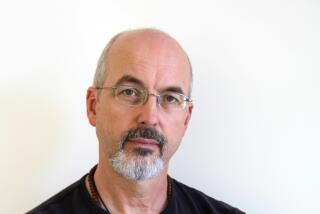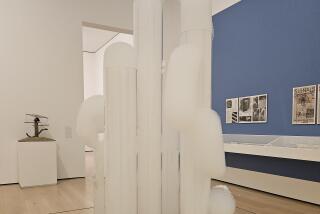John Frame and his sculptures get moving at the Huntington Library
By early 2006, John Frame had given up on art.
He had whittled away the year before in silence, as static in his work as the motionless sculptures that populated his cramped Wrightwood studio. He couldnât start a single project. Everything seemed wrong.
âI had shut down,â he said.
But then, a week or two after closing his studio door for good, he woke up from his artistic torpor â at 2 in the morning, inspired like heâd never been before.
âIt came as a single download,â Frame said. âIt was all the characters, it was dialogue, it was sets, it was plot, it was story line â everything, it was all there.â
In the morning, his wife brought him a stack of paper, and in a state somewhere between waking and sleeping, he started writing â âlike taking dictation,â he said.
âI should have seen it before,â he remembers thinking. âAll I have to do is make the figures move.â
Five years later, that vision has become a reality. This Saturday, in the MaryLou and George Boone Gallery at the Huntington Library, Arts Collections, and Botanical Gardens, Frameâs new exhibition, âThree Fragments of a Lost Tale: Sculpture and Story by John Frame,â will open. Almost every piece in the show â some three dozen in total, ranging from 31/2 to 32 inches high â is movable. Not only are they movable, but they are featured in photography and animation that bring them to life in the exhibition space.
Jessica Todd Smith, chief curator of American art at the Huntington, thinks that Frameâs work always held this multidimensionality, but it had never been fully realized until now.
âHis work always looked like it could move or might move or should move,â said Smith, who saw Frameâs early work at a career retrospective in 2005. âNow it does move.â
Originally, Frameâs intent for the new exhibition was never to showcase the sculptures themselves, fearful that he couldnât properly convey their movement. Instead, they were to be the subject of stop-motion animation. But as he began working on the pieces â fantastical creatures with pointy noses and expressive eyes, a combination of wood carvings and found objects â they became independent of the story. Now, Frame doesnât talk about any narrative through-line of the exhibition, preferring instead to let viewers take away whatever they can from the experience.
âEven though the meaning of the work may be difficult to explain, I think that people who are open to it feel it,â Frame said. âThey donât have to have it explained to them.â
Photographs were an obvious way to give the pieces extra dimensionality. But in keeping with his original vision, Frame also set out to create short animation pieces using the objects in the show, and the result is a 12-minute short that plays on a loop at the end of the exhibition, with vignettes featuring many of the characters.
Frame, who grew up in Southern California, wasnât exposed to art until college, but once he discovered that âthere was some way to see externally what I felt internally,â he never looked back. He studied art extensively and developed a voracious appetite for literature, counting Shakespeare and William Blake among his many influences.
But he was never impressed with contemporary art â he characterizes it, only somewhat jokingly, as piles of junk, stuffed animals and inflatables â which might explain his departure from 21st century artistic norms.
âHis muse is not popular culture â or, for that matter, contemporary culture, contemporary art or contemporary artists,â said Ann Harmsen, a veteran arts consultant in Los Angeles who has known Frame and his work for years. She added later, âJohn has burst open the inclusiveness of modern art.â
For the Huntington, an institution that Smith said has been âslow to catch up to the 21st century,â exhibiting Frameâs work is an opportunity to tie contemporary work to the past. Along with his show, Frame was invited to curate his own installation at the Huntington that would put his work in conversation with part of the institutionâs permanent collection. Running concurrent with his exhibition is âBorn to Endless Night: Paintings, Drawings, and Prints by William Blake Selected by John Frame.â
Twice now â once during college, and then years later when he thought his career was over â art awakened something inside Frame that he didnât know was there. He hopes his work will touch people in a similar way.
âArt changed my life completely, and I want to affect people with the work that I do in the same way I have been affected by the work of other artists,â he said.
âThree Fragments of a Lost Tale: Sculpture and Story by John Frameâ
Where: The Huntington Library, Art Collections, and Botanical Gardens, 1151 Oxford Road, San Marino
When: Saturday through June 20
Price: Adults $15 weekdays, $20 weekends; seniors $12 and $15; students $10; youth $6; children 5 and younger free.
Info: (626) 405-2100; https://www.huntington.org
More to Read
The biggest entertainment stories
Get our big stories about Hollywood, film, television, music, arts, culture and more right in your inbox as soon as they publish.
You may occasionally receive promotional content from the Los Angeles Times.










